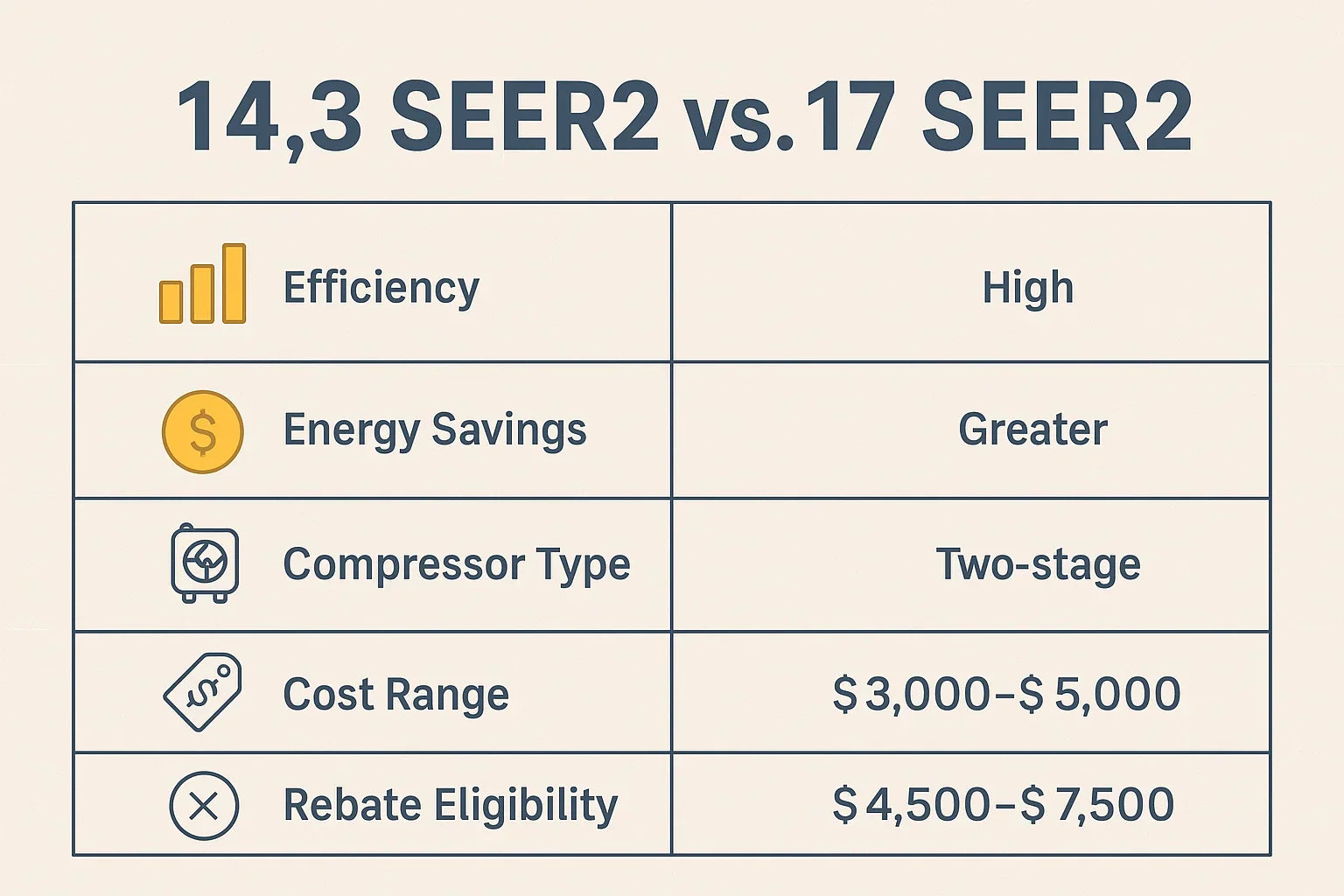If you're shopping for a new HVAC system in 2025, you're likely seeing terms like 14.3 SEER2 and 17 SEER2 in product specs. But what do these numbers really mean for your comfort, energy bills, and long-term investment?
In simple terms, SEER2 (Seasonal Energy Efficiency Ratio 2) measures how efficiently an air conditioner or heat pump cools your home. The higher the number, the more efficient the system — and the lower your electricity use.
But the difference between 14.3 and 17 SEER2 models goes beyond efficiency. We're talking about upfront cost, long-term savings, rebates, and even noise levels. Let’s break it down together.
📘 Carrier – Understanding HVAC Efficiency Ratings
14.3 vs. 17 SEER2: What’s the Actual Difference?
At first glance, a few points in SEER2 might not seem like much — but they represent a 15–20% jump in cooling efficiency. That can translate to significant long-term savings, especially in hot climates.
| Feature | 14.3 SEER2 | 17 SEER2 |
|---|---|---|
| Cooling Efficiency | Meets minimum U.S. standard | High-efficiency performance |
| Compressor Type | Usually single-stage | Often variable-speed or 2-stage |
| Comfort Control | Basic | Improved humidity + temp control |
| Noise Level | Louder | Quieter operation |
| Cost Range (Installed) | $4,500–$7,500 | $7,000–$11,000+ |
| Rebate & Tax Credit Eligible | Limited | Often eligible for full incentives |
📘 ACEEE – Residential Efficiency Standards
When 14.3 SEER2 Makes Sense
Choosing a 14.3 SEER2 unit isn’t “settling.” In fact, it can be the perfect fit if you:
✅ Live in a Mild Climate
If you're in the Pacific Northwest, upper Midwest, or northern states where summer cooling demands are minimal, a higher SEER2 may not pay for itself.
✅ Are Replacing a System in a Rush
Emergency replacements (especially in summer) often come down to availability and affordability. A 14.3 SEER2 unit meets federal standards and will still be more efficient than most systems over 10 years old.
✅ Have Budget Constraints
If the upfront cost of a 17 SEER2 system strains your budget, a right-sized 14.3 SEER2 unit can still provide strong comfort and moderate energy savings.
✅ Plan to Move Soon
If you're not planning to stay in the home for more than a few years, you may not recoup the long-term savings of a higher SEER2 model.
When 17 SEER2 Is Worth the Investment
A 17 SEER2 system often makes more sense in situations where:
🌡️ You Live in a Hot, Humid Climate
If you're in the South, Southwest, or parts of the Midwest, cooling costs are a major part of your utility bill. Higher SEER2 systems offer greater energy savings over time — sometimes hundreds per year.
🏠 You Own a Large or Two-Story Home
Larger homes benefit more from variable-speed and multi-stage cooling. These features reduce temperature swings and improve airflow throughout the home.
💸 You Want to Maximize Rebates or Tax Credits
High-efficiency SEER2 systems are more likely to qualify for federal tax credits under the 25C program, as well as local utility rebates.
📘 ENERGY STAR – Most Efficient HVAC Products
📘 DOE – 2025 HVAC Tax Credits
👷♂️ You’re Replacing the Ductwork or System Entirely
When you’re already investing in a full system overhaul, it’s often smart to install a higher-SEER2 model for maximum efficiency and comfort.
How Much Could You Actually Save?
Let’s look at a typical example. A 2,000 sq ft home with average cooling usage:
| System | Est. Annual Cooling Cost | Potential Annual Savings |
|---|---|---|
| Old 10 SEER Unit | $1,000 | — |
| 14.3 SEER2 | ~$700 | ~$300 |
| 17 SEER2 | ~$590 | ~$410 |
The jump from 14.3 to 17 SEER2 could save an additional $100–$150 per year, depending on climate and usage.
Over 10 years, that's $1,000+ in extra savings, not including rebates or avoided repair costs.
📘 Trane – HVAC Payback Analysis
Other Factors to Consider Before You Choose
🔧 Ductwork Compatibility
Higher SEER2 systems often need properly sized ductwork to deliver their full efficiency. If your ducts are old or leaky, factor in that upgrade.
🧾 Long-Term Value vs. Upfront Cost
The 17 SEER2 system may cost more today, but you could break even in 6–8 years from energy savings alone — even faster with rebates.
🛠️ Maintenance and Lifespan
Variable-speed systems (common in higher SEER2 units) may last longer and run fewer full-speed cycles, meaning less wear over time.
Final Thoughts from Alex Lane
Whether you go with a 14.3 SEER2 model or invest in a 17 SEER2 upgrade, the key is matching your system to your needs — not just chasing the highest number.
-
In milder climates or short-term homes, 14.3 SEER2 may be all you need.
-
For long-term savings, comfort, and rebates, 17 SEER2 can be worth every extra dollar.
Either way, don’t forget to size your system properly and check for local incentives. An efficient system only pays off if it’s installed right and fits your home.
📘 Ready to learn why SEER2 even matters in the first place?
🔗 What is SEER2 and Why It Matters
👉 Next up: SEER2 and HVAC Warranties: What Homeowners Should Know
Alex Lane
Your Home Comfort Advocate







